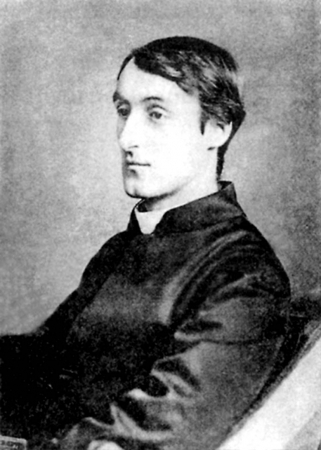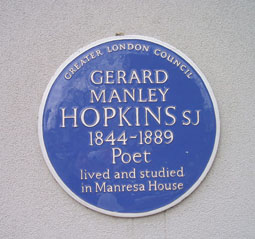|
庞鹤云
庞鹤云, 湖南 湘潭人。 毕业后分配到四川成都地质学院(现成都理工大学)任教授。
 

分组毕业照后排右起第一人为庞鹤云 1965

1960级女同学:前排左起张培华、许荣仙、孙学诗、蔡文美、王蕴茹
后排左起鲁琪、贺曼莉、庞鹤云、朱柏桐、谷启楠、刘秀清,1962年三八妇女节

前排左起孙学诗、蔡文美、许荣仙、汪莹、杨新芝、刘秀清;
后排左起朱柏桐、张培华、王蕴茹、谷启楠、庞鹤云、贺曼莉, 小礼堂前,early 60s

庞鹤云许荣仙于高东山祝宝银家,early 1980s
  
|
English Poet Gerard Manley Hopkins (1844-1889) |

G. M. Hopkins
(This work of art is in the public domain.)
Gerard Manley Hopkins, S.J. (28 July 1844 – 8 June 1889), was an English poet, Roman Catholic convert, and Jesuit priest, whose 20th-century fame established him posthumously among the leading Victorian poets. His experimental explorations in prosody (especially sprung rhythm) and his use of imagery established him as a daring innovator in a period of largely traditional verse. Much of Hopkins's historical importance has to do with the changes he brought to the form of poetry; which ran contrary to conventional ideas of metre. Prior to Hopkins, most Middle English and Modern English poetry was based on a rhythmic structure inherited from the Norman side of English literary heritage. This structure is based on repeating groups of two or three syllables, with the stressed syllable falling in the same place on each repetition. Hopkins called this structure "running rhythm", and though he wrote some of his early verse in running rhythm he became fascinated with the older rhythmic structure of the Anglo-Saxon tradition, of which Beowulf is the most famous example. Hopkins called his own rhythmic structure sprung rhythm. Sprung rhythm is structured around feet with a variable number of syllables, generally between one and four syllables per foot, with the stress always falling on the first syllable in a foot. In reality, it more closely resembles the "rolling stresses" of Robinson Jeffers, another poet who rejected conventional meter. Hopkins saw sprung rhythm as a way to escape the constraints of running rhythm, which he said inevitably pushed poetry written in it to become "same and tame." In this way, Hopkins can be seen as anticipating much of free verse. His work has no great affinity with either of the contemporary Pre-Raphaelite and neo-romanticism schools, although he does share their descriptive love of nature and he is often seen as a precursor to modernist poetry or as a bridge between the two poetic eras.
 
|
Pied Beauty
by Gerald Manley Hopkins |
|
| |
Glory be to God for dappled things --
For skies of couple-colour as a brinded cow;
For rose-moles all in stipple upon trout that swim;
Fresh-firecoal chestnut-falls; finches' wings;
Landscape plotted and pieced -- fold, fallow, and plough;
And all trades, their gear and tackle and trim.
All things counter, original, spare; strange;
Whatever is fickle, freckled, (who knows how?)
With swift, slow; sweet, sour; adazzle, d{'i}m;
He fathers-forth whose beauty is past change:
Praise him. |
|
God's Grandeur
by Gerald Manley Hopkins |
|
The world is charged with the grandeur of God.
It will flame out, like shining from shook foil;
It gathers to a greatness, like the ooze of oil
Crushed. Why do men then now not reck his rod?
Generations have trod, have trod, have trod;
And all is seared with trade; bleared, smeared with toil;
And wears man's smudge |&| shares man's smell: the soil
Is bare now, nor can foot feel, being shod.
And for all this, nature is never spent;
There lives the dearest freshness deep down things;
And though the last lights off the black West went
Oh, morning, at the brown brink eastward, springs --
Because the Holy Ghost over the bent
World broods with warm breast and with ah! bright wings.
|
|
The Starlight Night
by Gerald Manley Hopkins |
|
Look at the stars! look, look up at the skies!
O look at all the fire-folk sitting in the air!
The bright boroughs, the circle-citadels there!
Down in dim woods the diamond delves! the elves'-eyes!
The grey lawns cold where gold, where quickgold lies!
Wind-beat whitebeam! airy abeles set on a flare!
Flake-doves sent floating forth at a farmyard scare! --
Ah well! it is all a purchase, all is a prize.
Buy then! bid then! -- What? -- Prayer, patience, alms, vows.
Look, look: a May-mess, like on orchard boughs!
Look! March-bloom, like on mealed-with-yellow sallows!
These are indeed the barn; withindoors house
The shocks. This piece-bright paling shuts the spouse
Christ home, Christ and his mother and all his hallows.
|
|
Spring
by Gerald Manley Hopkins
|
|
| Nothing is so beautiful as spring --
When weeds, in wheels, shoot long and lovely and lush;
Thrush's eggs look little low heavens, and thrush
Through the echoing timber does so rinse and wring
The ear, it strikes like lightnings to hear him sing;
The glassy peartree leaves and blooms, they brush
The descending blue; that blue is all in a rush
With richness; the racing lambs too have fair their fling.
What is all this juice and all this joy?
A strain of the earth's sweet being in the beginning
In Eden garden. -- Have, get, before it cloy,
Before it cloud, Christ, lord, and sour with sinning,
Innocent mind and Mayday in girl and boy,
Most, O maid's child, thy choice and worthy the winning. |
|

Blue plaque commemorating Hopkins in
Roehampton, London
(Copied under the terms of the GNU Free Documentation License)
 
|
|

